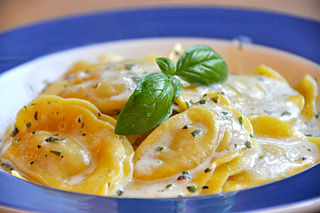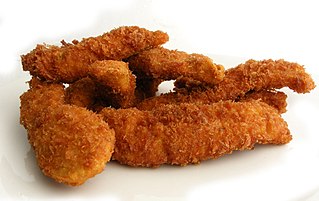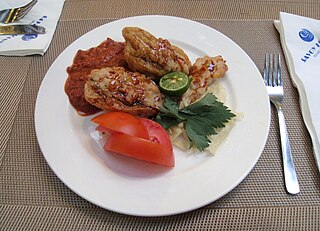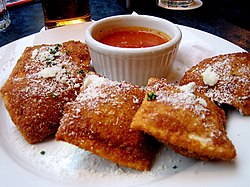
American Chinese cuisine is a cuisine derived from Chinese cuisine that was developed by Chinese Americans. The dishes served in many North American Chinese restaurants are adapted to American tastes and often differ significantly from those found in China.

The cuisine of the American Midwest draws its culinary roots most significantly from the cuisines of Central, Northern and Eastern Europe, and Indigenous cuisine of the Americas, and is influenced by regionally and locally grown foodstuffs and cultural diversity.

Ravioli are a type of stuffed pasta comprising a filling enveloped in thin pasta dough. Usually served in broth or with a sauce, they originated as a traditional food in Italian cuisine. Ravioli are commonly square, though other forms are also used, including circular and semi-circular (mezzelune).

A schnitzel is a thin slice of meat. The meat is usually thinned by pounding with a meat tenderizer. Most commonly, the meat is breaded before frying. Breaded schnitzel is popular in many countries and is made using veal, pork, chicken, mutton, beef, or turkey. Schnitzel originates in Austria as wiener schnitzel and is very similar to dishes such as escalope in France and Spain, panado in Portugal, tonkatsu in Japan, cotoletta in Italy, kotlet schabowy in Poland, řízek in Czech Republic, milanesa in Latin America, chuleta valluna in Colombia, chicken chop in Malaysia, and chicken-fried steak and pork tenderloin of the United States.

Chicken fingers are chicken meat prepared from the pectoralis minor muscles of the animal. These strips of white meat are located on either side of the breastbone, under the breast meat. They may also be made with similarly shaped pieces cut from chicken meat, usually the breast, or sometimes just pulverized chicken flesh.

A hush puppy is a small, savory, deep-fried round ball made from cornmeal-based batter. Hushpuppies are frequently served as a side dish with seafood and other deep-fried foods.
Oysters en brochette is a classic dish in New Orleans Creole cuisine. Raw oysters are skewered, alternating with pieces of partially cooked bacon. The entire dish is then broiled or breaded then either deep fried or sautéed. The traditional presentation is on triangles of toast with the skewer removed and dusted with salt and pepper or topped with either Maitre d'Hotel butter or a Meunière sauce. When prepared well, the dish should have a crispy exterior and a soft savory center with a textural contrast between the bacon and the oyster. It was usually offered on restaurant menus as an appetizer; but was also a popular lunch entrée.

Batagor is a Sundanese dish from Indonesia, and popular in Southeast Asia, consisting of fried fish dumplings, usually served with peanut sauce. It is traditionally made from minced tenggiri, although other types of seafood such as tuna, mackerel, and prawn may also be used. The fish paste is subsequently stuffed into wonton skins or filled into tofu, and then deep-fried in palm oil.

Breaded cutlet or braised cutlet is a dish made from coating a cutlet of meat with breading or batter and either frying or baking it.

The cuisine of St. Louis is largely influenced by the city’s German, Irish, Italian, Mexican, Chinese, and Vietnamese immigrant population and African Americans who migrated from the Southern United States.

Mamma Campisi's, formerly Oldani's and commonly known as Mama's on the Hill, is a restaurant in St. Louis, Missouri, which is located on The Hill, which is the "Little Italy" in that city, and one of the premier sources of Italian Cuisine in the United States.

Dumpling is a broad class of dishes that consist of pieces of cooked dough, often wrapped around a filling. The dough can be based on bread, wheat or other flours, or potatoes, and it may be filled with meat, fish, tofu, cheese, vegetables, or a combination. Dumplings may be prepared using a variety of cooking methods and are found in many world cuisines.

Jiaozi are a type of Chinese dumpling. Jiaozi typically consist of a ground meat and/or vegetable filling wrapped into a thinly rolled piece of dough, which is then sealed by pressing the edges together. Finished jiaozi can be boiled, steamed, pan-fried, or deep-fried, and are traditionally served with a black vinegar and sesame oil dip. They can also be served in a soup.

Sorrentinos are a type of Argentine ravioli, but larger, more circular and originally wraped without fluted edge. The dough is made with flour and eggs, and the filling of the original recipe consists of York ham and mozzarella.













